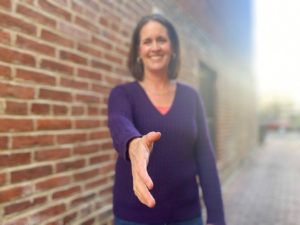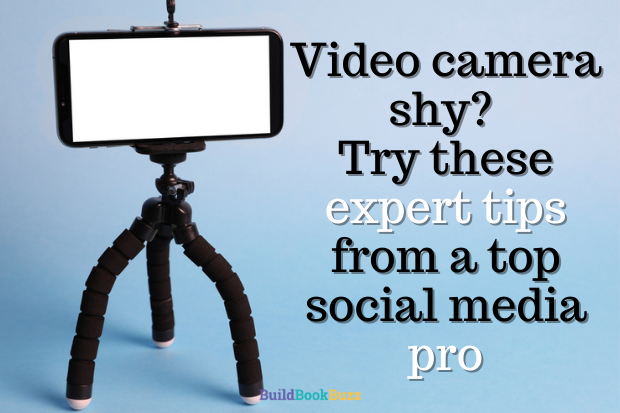Video camera shy? Try these expert tips from a top social media pro
Are you video camera shy? Social media pro Amy Rogers Nazarov offers tips for becoming more camera confident in social media videos.
Last month, Amy Rogers Nazarov instructed us on how to engage followers on social media in her inspiring article, “Let’s get engaged: How to use social media effectively.” That was such a hit that I invited her back! This time, Amy’s addressing an issue some of you might have in common with me: How to get comfortable being on camera in social media videos.
Amy is a former journalist who teaches people how to use social media more effectively, with less scrolling and more serendipity. Before she launched Spark: Social Media Strategy in 2014, she was both a freelance and staff writer. Amy’s byline has appeared in Cooking Light, Slate, The Washington Post, and American Songwriter among many others. Be sure to check out her affordable course, Seven Easy Social Media Hacks for Entrepreneurs & Creatives, especially if you find her articles here helpful.
Video camera shy? Try these expert tips from a top social media pro
By Amy Rogers Nazarov
One day last week I coached three clients on posing and speaking for my smartphone camera so I could build up a little bank of content to draw upon for various social media purposes.
Two are in the home renovation world, the other in performing arts. Each is a confident, accomplished, expressive person thriving in their respective industry.
Yet when I told them we’d be generating video for their social media feeds, dismay flashed across their faces. (The good news is that as I coached them, they all relaxed into the process. We had some fun with it, and I got what I needed. Here’s one of the results.)
Feeling vulnerable?
I tell you this to remind you that if you feel vulnerable trying to make a TikTok video about your release date, or to participate in an Instagram Live with your agent, you have lots of company!
Number one, most people feel anxious at first when showing their voices and faces on social media.
Number two, with practice, you won’t always feel that way.
And number three, nothing is better for building your credibility and trustworthiness with your followers than letting them see and hear you.
Nothing is better for building your credibility and trustworthiness with your followers than letting them see and hear you. ~ Amy Rogers NazarovClick to tweet3 steps to camera confidence
Ready to feel less video camera shy? Feeling confident on camera will actually make the time you spend on social more fulfilling.
Here’s a step-by-step plan to help you grow your confidence and get comfortable showing up on social media.
1. Start small.
Think of a topic you know inside and out: why you decided to self-publish, the benefits of publishing on demand, why you love to write at your kitchen table, the best YA book you ever read.
2. Rehearse.
Jot down a few lines about this topic, no more than three to start. Read them aloud in a conversational tone, as many times as necessary to sound fluid and conversational. Try speaking into the mirror or to a friend.
3. Speak on camera.
Use your phone’s reverse feature to train the lens on yourself and capture a video of you speaking the lines. Play it back, checking for good eye contact with the camera and that there are no visual distractions in the background. Re-record as needed.
Pro tip: Make eye contact with the camera lens, not with your own reflection. That way it will appear that you are speaking directly to your listener.
Getting on camera, without getting on camera
To get my clients comfortable with this, I suggest they try a couple of approaches that help them slowly move into that full-on, talking head visual that so many are so good at, but others find intimidating. Here’s what I recommend to them and you.
Start with stills.
Just as you walk before you run, try sharing a selfie before a video clip of you speaking.
Partially obscure your face.
It might feel less intimidating to peek out from behind a prop – an N95 mask, a hat, a plant, a laptop lid – in your first selfie or first video.

Blur it.
Tilt Shift, Portrait mode and other settings allow us to make part of our image blurry, while rendering another part more crisply.

Voiceover.
Many social media platforms have a voiceover feature that let you narrate a process – reviewing galleys, say, or writing an outline for an article, making your morning coffee, taking your afternoon stroll to clear out writers’ block.
Props for props!
Speaking of props, they tick a lot of boxes. Just a few:
They add instant flavor and personality to your social media content. How about:
- A hat or other article of clothing
- A mascot, like a pet or a goldfish
- Something that reflects your brand colors
- The cover of your last book

They can convey a message without your having to say it aloud. How about:
- A political poster, current or vintage, that hints at or makes obvious your affiliation
- A religious symbol
- A view out your window to the city or rural setting where you live or work
They can be used as a signature piece in all your content for continuity. Consider:
- A slogan
- A sign
- A memento
- A location
- A piece of wall art
Breathe!
Whatever method you use as you begin to show your face little by little on your feeds, a key thing to remember is one of the simplest, and that is this: Take a deep breath. You’ve got this – or, perhaps more accurately, you will get this.
Giving your followers a window into who you are and what makes you tick as a writer can be one of the most fun parts of social media.
Giving your followers a window into who you are and what makes you tick as a writer can be one of the most fun parts of social media. ~ Amy Rogers NazarovClick to tweetRemember: your followers are already interested in you and what you have to say. As you let them see and hear you, the quality of your interactions with them will only grow richer.
Are you using video in your book marketing? Tell us about it in a comment! And if you aren’t, what’s holding you back? Maybe we can help.
Like what you’re reading? Get it delivered to your inbox every week by subscribing to the free Build Book Buzz newsletter. You’ll also get my free “Top 5 Free Book Promotion Resources” cheat sheet immediately!



The comment about taking a deep breath is the opposite of what I was taught. Breathing in can result in a higher-pitched voice, so what I was told was to breather out before speaking. Expel as much air as possible. This lowers your shoulders, which helps you relax. Your body will take care of your next inhale. It’s never failed me…
Gabi, I believe Amy was referring to an effective relaxation technique: Take a deep breath, then exhale. You’ll feel calmer after that simple step and therefore better prepared to face the camera. It’s a commonly used phrase that isn’t followed by “then exhale.” She wasn’t suggesting that you inhale then talk while you’re holding your breath.
Sandy